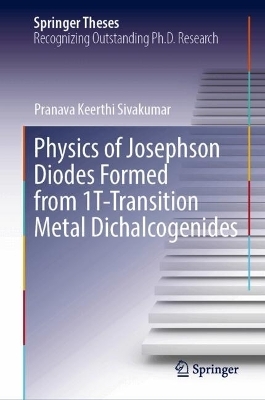
Physics of Josephson Diodes Formed from 1T-Transition Metal Dichalcogenides
Springer International Publishing (Verlag)
978-3-031-81604-8 (ISBN)
- Noch nicht erschienen - erscheint am 07.02.2025
- Versandkostenfrei
- Auch auf Rechnung
- Artikel merken
Pranava Keerthi Sivakumar has done his BS-MS (Chemistry) at the Indian Institute of Science, Bengaluru, India. He completed his Ph.D. in Physics at the Max Planck Institute of Microstructure Physics and Martin Luther University in Halle, Germany under the supervision of Prof. Stuart S. P. Parkin and graduated with the highest honors (summa cum laude) for his dissertation. During his Ph.D., he worked on a variety of topics including electrical detection of topological spin textures, current-induced antiskyrmion motion, and anomalous Hall effects in non-collinear antiferromagnetic systems. Most notably, as described in his dissertation, he set up and carried out low-noise electrical transport measurements on Josephson junctions of two-dimensional van der Waals transition metal dichalcogenides sandwiched by superconducting niobium electrodes at ultra-low temperatures in a dilution refrigerator setup assembled by himself during his Ph.D. He has identified large non-reciprocal critical currents in the presence of a magnetic field, and experimentally verified a mechanism based on the formation of finite-momentum Cooper pairs, that can reliably explain the existence of this effect in systems with spin-momentum locking due to broken inversion symmetry. The discovery itself and the in-depth understanding of its underlying physics provided in his work is both technologically and fundamentally significant; as such effects have recently attracted a lot of attention in the condensed matter physics community for both their potential in creating dissipation less superconducting devices and as a tool in identifying unconventional superconductivity.
Chapter 1.Introduction and scope of the thesis.- Chapter 2.Theoretical Foundations.- Chapter 3.Experimental methods.- Chapter 4.Josephson diode effect induced by finite momentum Cooper pairing in a topological Rashba system 1T-NiTe2.- Chapter 5.Helical spin-momentum locking and tunable second-order junctions in the Dirac semimetal 1T-PtTe2 probed by the Josephson diode effect.- Chapter 6.Conclusions and outlook.
| Erscheint lt. Verlag | 7.2.2025 |
|---|---|
| Reihe/Serie | Springer Theses |
| Zusatzinfo | Approx. 190 p. 80 illus., 75 illus. in color. |
| Verlagsort | Cham |
| Sprache | englisch |
| Maße | 155 x 235 mm |
| Themenwelt | Naturwissenschaften ► Chemie |
| Naturwissenschaften ► Physik / Astronomie ► Festkörperphysik | |
| Technik ► Maschinenbau | |
| Schlagworte | Dirac semimetal • helical spin-momentum locking • higher-order Andreev reflections • Josephson diode effect • josephson junctions • local inversion symmetry breaking • long-range coherence • nickel telluride NiTe2 • platinum telluride PtTe2 • Rashba spin-momentum locking • superconducting diode effect • Topological Surface States • Transition metal dichalcogenides • tunable second harmonic supercurrents |
| ISBN-10 | 3-031-81604-8 / 3031816048 |
| ISBN-13 | 978-3-031-81604-8 / 9783031816048 |
| Zustand | Neuware |
| Haben Sie eine Frage zum Produkt? |
aus dem Bereich


